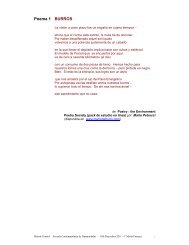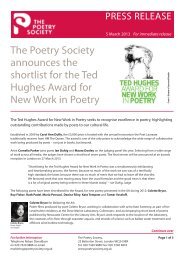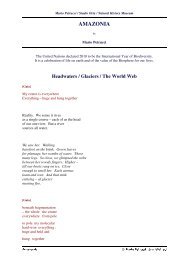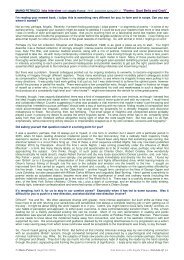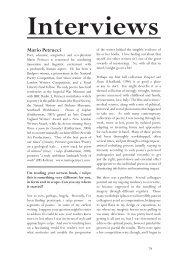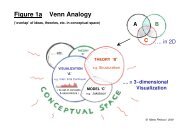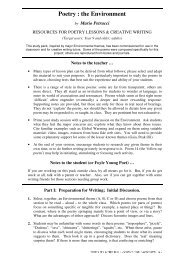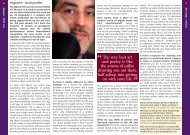Scientific Visualizations: Bridge-Building between ... - Mario Petrucci
Scientific Visualizations: Bridge-Building between ... - Mario Petrucci
Scientific Visualizations: Bridge-Building between ... - Mario Petrucci
You also want an ePaper? Increase the reach of your titles
YUMPU automatically turns print PDFs into web optimized ePapers that Google loves.
286 MARIO PETRUCCI<br />
figure 4<br />
Adaptation/mutation. Analogy for the evolving perception of an author/text.<br />
style. As with DNA, though, the particular codes associated with a text do<br />
not determine exactly how that textual creature will look or perform (within a<br />
particular brain or culture), thus opening up that old debate: nature vs.<br />
nurture. The analogy also recognizes how textual codes can be intimately<br />
responsive to the complex, shifting environment of literary ideas and cultural<br />
signs. A type of Darwinism is implied here, with certain variations of code<br />
surviving because they are fit for the altered environment (e.g. they align<br />
with new thinking). These changes in meaning can be adaptive (i.e. slight and<br />
slow, as in much of natural selection), as when an author’s style gradually<br />
accrues esteem across generations; or they can be rapid and substantial (a<br />
sudden mutation), e.g. if a discovered cache of letters forces deep and precipitous<br />
re-evaluation of a famous biography.<br />
Naturally, the analogy has its flaws. Texts do not really behave — or<br />
propagate themselves, generation to generation — as do animals or DNA<br />
(though Dawkins’ (1976) self-replicating units of culture, memes, may bring<br />
some validity to the overall notion). Nor do I use the terms adaptation/<br />
mutation quite as technically defined in biology (my sense of mutation here is<br />
much closer to the populist idea of a severe alteration, or a mutant strain, as<br />
precipitated, say, by radiation). One might also challenge the very notion of<br />
codes preserved in the text, invoking instead reader-centred theories where<br />
the receiver (not the author, nor even the text itself) is the primary creator of<br />
the text’s meaning. A fresh analogy there might be that of a textual quarry<br />
the reader excavates, seeking and constructing her own meanings from the<br />
raw materials of words and associations. This shows how analogies, once<br />
their inadequacies are acknowledged and incorporated, can be propped<br />
against one another to develop an evocative, extended mode of entry into a<br />
subject.<br />
INTERDISCIPLINARY SCIENCE REVIEWS, Vol. 36 No. 4, December, 2011



